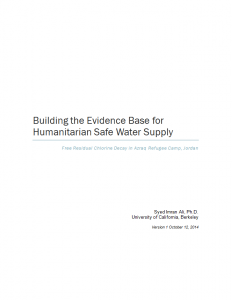
Current emergency safe water guidelines are based on little field evidence. We launched an observational study on chlorine decay in the Azraq refugee camp, Jordan in July-August 2014 in order to: i) develop evidence-based guidelines for centralized batch chlorination in humanitarian operations; and ii) identify factors affecting the safe water chain. This study builds on earlier work from South Sudan and adds to the evidence base that study initiated.
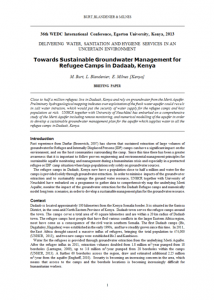
Close to half a million refugees live in Dadaab, Kenya and rely on groundwater from the Merti Aquifer. Preliminary hydrogeological mapping indicates over exploitation of the fresh water aquifer could result in salt water intrusion, which would put the security of water supply for the refugee camps and host population at risk. UNHCR together with University of Neuchâtel has embarked on a comprehensive study of the Merti Aquifer including remote monitoring, and numerical modelling of the aquifer in order to develop a sustainable groundwater management plan for the aquifer which supplies water to all the refugee camps in Dadaab, Kenya.
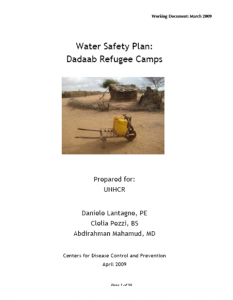
Water safety plan produced by CDC following a technical support visit to Dadaab in 2009. The report contains: An overview of Dadaab water supply system; Identification of hazards and risks; Control measures and prioritisation of risks; Sanitation and hygiene; and Conclusions.
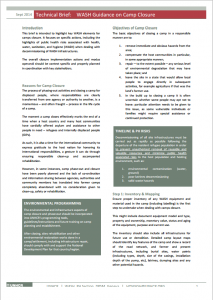
This brief is intended to highlight key WASH elements for camps closure. It focuses on specific actions, including the highlights of public health risks associated with health, water, sanitation, and hygiene (WASH) when dealing with decommissioning of WASH infrastructures. The overall closure implementation actions and modus operandi should be context specific and properly planned in coordination with key stakeholders.
Tags: Camp Closure, Cross Cutting, Environment, Excreta Management, Solid Waste Management, WASH Coordination, WASH Programme Health and Safety, WASH Programme Management, WASH Strategy Development, and Water Supply. Languages: English. Organisations: UNHCR. Categories: WASH Guidelines, WASH Operational Guidelines, WASH Policy Guidelines, and WASH Reference Documents.

Tazalit Country Niger Camp Tazalit Latitude [°] 16°54’01.5″N Longitude [°] 5°15’48.4″E Elevation [m.a.s.l.] 374 Drilling date [dd/mm/yyyy] 2003 Depth [m] 430 Static water level [m] 41.2 Pump Brand and Model Grundfos, SP30A08 Type of pump Electrical pump Pump depth [m] 74.1 Pump motor power [kW] 15 Type of energy relied on Generator Casing diameter [inch] […]
Tags: Boreholes, Drilling, and Water Supply. Locations: Africa, Niger, and West Africa. Languages: English. Organisations: UNHCR. DatabaseDocTypes: Borehole Drilling Logs.

These WASH related primer questions have been designed to assist UNHCR and WASH actors collect data from key informants and focus groups during WASH assessments. The list of questions is not exhaustive and is merely intended as a conversation primer (aide memoire).
Tags: Excreta Management, Human Right to Water / Sanitation, Hygiene Promotion, Protection, Public Health, Solid Waste Management, WASH Assessments, WASH Monitoring, WASH Strategy Development, and Water Supply. Languages: English. Organisations: UNHCR. Categories: WASH Blank Forms, WASH Emergency Guidelines, WASH Emergency Tools, and WASH Reference Documents.

This is the standard UNHCR borehole drilling log and pump test template available in PDF and MSWord formats. WASH actors should ensure that a drilling log, development log, constant discharge pump test, and step drawdown pump test are completed for every borehole installed. Copies should be kept by the drilling agency, the WASH actor, national regulatory authorities, and UNHCR.

Agency information Drilling Agency: UNHCR Drilling Officer: Mesfin Yagatu Contact Details: yagatu@unhcr.org 7882343 Name of Geologist: Ngusu Atamara Drilling Method: Rotary and DTH Drilling Rig Make and Model: PAT 301 Drilling Fluid Used: Foam Drilling Bit Sizes: 6″ 8″ Date Started: 12/04/2001 Date Completed: 17/04/2001 Borehole location District: Sherkole Zone ‘F’ Sub-district: None Village / […]
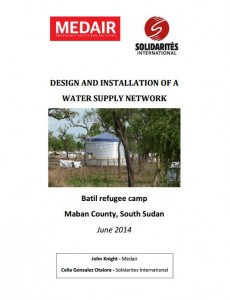
This document provides an overview of the design of the water system in Batil Refugee Camp, S. Sudan.
 English
English









